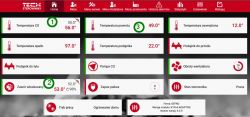Hello,
I finally kindled a new boiler and it was the simplest thing to do. The problem or "problem" appeared, as it was necessary to put some parameters on the controller. I got out after a few hours, because the paper manual (28 pages), I am already in front of my eyes, the more so because the naming is not always unambiguous in relation to what on the controller image.
Someone had to change it before, so I'm counting on help. To make it simpler, I put a screenshot of the application that supports the driver.
Primarily:
- what is [Temperature of CO] nr (1) in the image I just set at 55 °. This temperature is given, and the boiler keeps it. OK, but where is it measured and how it affects other temperatures - [Return temperature] (3) whether [Built-in valve] (2) ?
- what is the temperature [built-in valve] (2) which can be set manually, and after switching on the weather sensor is set by the controller according to the heating curve? Where is it measured and how this [Valve temperature] has up to [CO Temperature]
- what temperature does the radiators actually supply (1) whether (2) or some other one?
- where [Return temperature] is measured (3) and why, if I set the [Return protection] menu, this [Return temperature] is set at the set altitude, but the radiators stop heating?
Other things besides these unfortunate temperatures: why is it possible to change the boiler's power - what is the positive effect?
If I turn off the PID, then the boiler does not work automatically?

Thanks in advance for even partial help.
greetings
I finally kindled a new boiler and it was the simplest thing to do. The problem or "problem" appeared, as it was necessary to put some parameters on the controller. I got out after a few hours, because the paper manual (28 pages), I am already in front of my eyes, the more so because the naming is not always unambiguous in relation to what on the controller image.
Someone had to change it before, so I'm counting on help. To make it simpler, I put a screenshot of the application that supports the driver.
Primarily:
- what is [Temperature of CO] nr (1) in the image I just set at 55 °. This temperature is given, and the boiler keeps it. OK, but where is it measured and how it affects other temperatures - [Return temperature] (3) whether [Built-in valve] (2) ?
- what is the temperature [built-in valve] (2) which can be set manually, and after switching on the weather sensor is set by the controller according to the heating curve? Where is it measured and how this [Valve temperature] has up to [CO Temperature]
- what temperature does the radiators actually supply (1) whether (2) or some other one?
- where [Return temperature] is measured (3) and why, if I set the [Return protection] menu, this [Return temperature] is set at the set altitude, but the radiators stop heating?
Other things besides these unfortunate temperatures: why is it possible to change the boiler's power - what is the positive effect?
If I turn off the PID, then the boiler does not work automatically?

Thanks in advance for even partial help.
greetings


